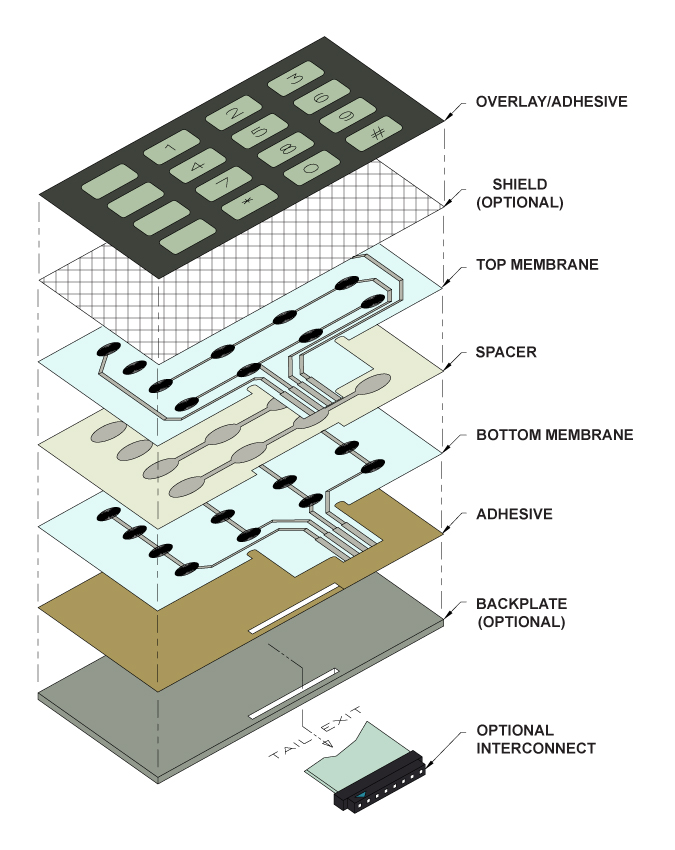Why Membrane Switches Are a Preferred Choice for Medical Instruments
Why Membrane Switches Are a Preferred Choice for Medical Instruments
Blog Article
Why Membrane Changes Are Necessary for Sturdy Control Systems
Membrane switches play a pivotal role in ensuring the longevity and integrity of control systems throughout different industries. As we explore the complex benefits of membrane switches, it becomes apparent that their relevance goes beyond plain capability, influencing user experience and functional effectiveness.
Review of Membrane Buttons
Membrane layer switches are functional and reputable elements typically made use of in different digital control systems. These switches consist of numerous layers, including a visuals overlay, a spacer layer, and a published circuit layer. The visuals overlay supplies both practical and aesthetic design, while the spacer layer makes certain that the switches are turned on only when pushed. The printed circuit layer has conductive traces that complete an electric circuit when the membrane is pressed, making it possible for the gadget to react to individual inputs.
Membrane layer switches are typically preferred in applications requiring a small and light-weight layout, making them perfect for portable tools, medical devices, and commercial equipment. They can be customized to meet certain customer requirements and can integrate numerous attributes such as backlighting, responsive feedback, and multiple colors. In addition, membrane switches are resistant to dust, wetness, and impurities, making them ideal for environments where sturdiness is essential.
Benefits of Longevity
In many applications, the resilience of membrane switches offers considerable benefits that boost their overall performance and dependability. These switches are designed to withstand harsh environments, making them perfect for use in demanding conditions such as high moisture, severe temperature levels, and direct exposure to chemicals. Their robust building aids to prevent damage from physical impact, guaranteeing long-lasting performance and minimizing the need for frequent replacements.
Additionally, membrane buttons are immune to damage, which is important in applications where frequent interaction takes place. This longevity equates to lower upkeep prices, as organizations take advantage of reduced downtime and less service interruptions. In addition, the encapsulated layout of membrane switches shields interior components from dirt and wetness ingress, more adding to their lifespan.
Another benefit is their capability to maintain constant performance gradually. With a high tolerance for mechanical stress and anxiety, these switches maintain their tactile responses and electrical honesty, guaranteeing user fulfillment. Ultimately, the longevity of membrane switches over not only improves functional effectiveness yet also cultivates self-confidence in their reliability, making them a favored choice for control systems across numerous sectors.
Applications in Different Industries
Durable control systems employing membrane layer switches locate considerable applications across a series of sectors, each taking advantage of the special features these switches use. In the clinical sector, membrane buttons are critical for gadgets such as individual monitors and diagnostic devices, where integrity and convenience of cleaning are vital. Their resistance to dampness and pollutants ensures they maintain functionality in clean and sterile settings.
The automobile sector leverages membrane buttons for dashboard controls and infotainment systems, where they provide sleek, inconspicuous user interfaces that improve user experience. These switches are additionally made Continued to stand up to extreme problems, including exposure to severe temperatures and vibrations.
In commercial setups, membrane layer buttons are generally made use of in equipment control board, offering tactile feedback and resilience required for high-usage applications. Their capability to resist chemicals makes them suitable for producing environments where spills and pollutants are regular.

Customer electronic devices, such as cooking area appliances and remote controls, likewise make use of membrane layer buttons for their adaptability and cost-effectiveness. In general, the versatility and robust nature of membrane layer changes make them vital across various fields, making certain effective operation and see here longevity in control systems.
Layout and Visual Allure
While performance is paramount, the layout and visual appeal of control systems equipped with membrane layer switches play a crucial duty in individual engagement and total experience (membrane switch). The visual design of these buttons can considerably affect individual assumption and interaction. A properly designed membrane switch improves the beauty of the tool, making it much more appealing to individuals and fostering a link between the customer and the product
Membrane layer switches supply a good deal of versatility in design, enabling manufacturers to personalize graphics, colors, and structures to align with brand identification and product appearances. Making use of vivid colors and distinct patterns can draw interest, while responsive feedback can strengthen the user's interaction with the tool. Additionally, the capability to incorporate LED indicators and backlighting right into the membrane switch layout provides both practical and visual benefits, improving exposure and use in various atmospheres.

Enhancing User Experience

Moreover, membrane switches can be customized to include visual user interfaces, enhancing usability by presenting information in a clear and intuitive manner (membrane switch). This customization can include icons, labels, and color coding that guide customers via facility capabilities easily. Additionally, their convenience permits for assimilation in numerous settings, making certain regular efficiency whether in commercial equipment or consumer electronics
The resilience of membrane switches additionally plays an essential duty in customer experience. By standing up to severe conditions and extended usage, these buttons minimize the possibility of system failures, thus advertising dependability and individual confidence. Inevitably, the calculated use of membrane switches over not just raises functionality yet likewise considerably enriches customer interaction with control systems, making them an essential component in modern-day style.
Conclusion

Report this page